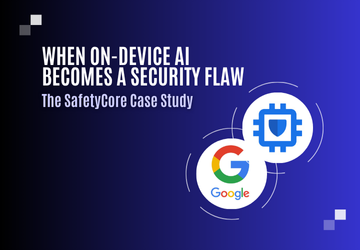Protect Your On-Device Artificial Intelligence Algorithms: Encryption Is Not Enough!
On-Device Artificial Intelligence (AI) is an invaluable asset to many industries, offering revolutionary capabilities in analysis and prediction. But with this technological comes a major concern: the security of AI models. Companies invest heavily in the research and development of their algorithms, so how can they protect them from extraction and unauthorized copy? In this article, we will explain the shortcoming of classical software protection, and how SKYLD’s SDK can help you implement this essential protection.
This post answer :
- Why should I protect my on-device AI algorithms?
- How can I protect my on-device AI model?
Understanding how Model Reverse Engineering Works
A model is stored in a file that will be excuted by the ML framework (eg, ONNX). Encryption of this file is a popular strategy to protect the parameters and intellectual property. Without a key, no one can read your model, right?
However, when your model is deployed on-device, the attacker can perform dynamic reverse engineering. At some point, the program needs to decrypt the model to be able to perform its task. An attacker can stop the execution at the exact time when the model is decrypted and load into the memory to be executed, and retrieve the model at this moment.
Why Should I Protect My On-Device AI Algorithms?
-
Intellectual Property and Competitive Edge Protection:
Model extraction attacks pose a risk of intellectual property theft, allowing competitors or malicious actors to replicate the original model. Attackers can also fine-tune your model with just a fraction of the necessary data to train a competitive algorithm. Protecting your AI investment is crucial for maintaining your competitive edge. -
Model Monetization:
Without any protection, a model can be copied and used beyond the original authorization. In the case of a licensed model, that can be used during only a certain amount of time, or only in a given number of devices, a protection is needed to enforce the right use of the model. -
Security and Trustworthiness:
A compromised model can have serious consequences, especially in applications where security is paramount, such as in finance, healthcare, or critical infrastructure. If attackers can extract a model, they may perform powerful white-box adversarial attacks, creating data that will deceive the model, and evade classification or detection. -
Data Privacy and Compliance:
When machine learning models are trained on sensitive data, extracting the model may reveal information about the training data. A competitor may also gain insights on how the training set is built, and even recover part of your training data.
 Example of model extraction attacks
Example of model extraction attacks
How Can You Protect On-Device AI Models?
Crafting a protection for on-device AI models must consider the specifities of artificial intelligence algorithms. Encryption of the weights file is not enough, as it can be decrypted during runtime. Obfuscation will not protect the parameters’ file, but will only increase the difficulty to access the file.
—> You need a protection that protect the weights during runtime.
How Skyld Can Assist You?
SKYLD offers a specialized development kit for on-device AI model protection. With our advanced technology, your AI models will be safeguarded against the most sophisticated attacks.
To learn more about our development kit and how it can enhance the security of your AI models, feel free to contact us today. Protect your competitive edge and unlock the power of on-device Artificial Intelligence.





